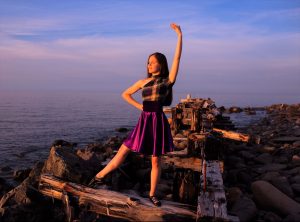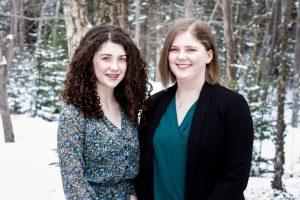
Meet the new generation of Celts. These teens and young adults are proof that young people continue to be interested in Celtic culture – whether they live in a Celtic nation themselves or celebrate their heritage here on the East Coast of Canada. These are but a few of the many young folks contributing to Celtic arts, language preservation, social justice and more. As tomorrow’s political leaders, teachers, artists, storytellers, and mentors, they are crucial to the future of Celtic culture.
“When I think of ‘Celtic’ I think of the tribes that we descended from and their culture and customs,” says Anna Sheehan, a 21-year-old European Studies student at Trinity College Dublin. “We learned a lot about them when I was younger because of the importance my school placed on heritage and culture. It makes me feel connected to something ancient, beautiful and powerful.”
Alys Hall echoes the sentiment. For the 17-year-old, “Celtic” is reminiscent of ancient times and traditions. However, she acknowledges those traditions remain essential to the Celtic identity today. “The folk songs, the folk music is really important,” she shares. “There is a lot of mythology. The most important thing about it, I believe, is the history of it.”
Hall, who lives in Wales, says that most people outside of the country don’t understand that the Welsh have their own language and identity. Some don’t even realize Wales is a separate country from England. “If you go to the Celtic countries, like Ireland or you go to Brittany, they do understand a lot more. Outside of those countries, there is really no knowledge at all.” She wishes people knew more about Welsh history, because “it is really interesting,” and the Welsh influence can be found all over the world.
Education, Language and Heritage
A member of the Welsh Youth Parliament, Hall is passionate about issues like support for LGBTQ+ and disabled students. She has attended Welsh language schools since preschool.
“It is a much more popular choice now to send your kids to a Welsh school than it used to be, and it is important that we keep promoting it and that we keep helping it to grow.”
Likewise, Sheehan benefitted from attending a school focused on her country’s native language. Her mother, Fiona, enrolled her in a gaelscoil (an Irish-speaking school) and Sheehan became fluent in the Irish language by the time she was eight. In addition to language, the gaelscoil allowed her to tap into other aspects of Irish culture, including Irish dance, traditional music, and Gaelic football and hurling – a sport that dates back to 1272 BC.
“I am a singer, so being connected to my roots and ancestors through music helped me grow a lot as a musician and made me very proud of my culture. We learned about Irish history and Celtic history in much more detail than most schools. By the time I left primary school at 12 I had been fully immersed in my culture and, like most people I know who went to all Irish-speaking schools, I had fallen totally in love.”
 Although she attended an English high school, Sheehan spoke Irish at home and with her Irish-speaking friends. “I continued to study music in school and promoted traditional Irish music by using traditional pieces in my exams and helping others with their Irish music exam questions by giving them way more detail than they needed.
Although she attended an English high school, Sheehan spoke Irish at home and with her Irish-speaking friends. “I continued to study music in school and promoted traditional Irish music by using traditional pieces in my exams and helping others with their Irish music exam questions by giving them way more detail than they needed.
“I love all my friends and family but there is something special about the relationships I have with people who I speak to in Irish.”
“We share a deep love and respect for the language. I have never met a person who has gone to an all-Irish school or taken it upon themselves to learn the language who hasn’t felt this deep connection to it. It is a compulsory subject for most students in school and people have grown to dislike it as it is taught wrong in English-speaking schools, but I am seeing now that a lot of people are taking it upon themselves to improve and use their Irish in college which I am indescribably happy about. It feels like the language is getting another chance at life.”
Fortunately, education in Celtic languages isn’t confined to the Celtic nations. In fact, two of the people leading the charge for Scottish Gaelic education in Nova Scotia, Canada, are a pair of teenage girls.
Abby and Ella Hanson (ages 18 and 16, respectively) run educational workshops under the name Up With Gaelic. The young women initially became interested in Celtic culture several years ago when they started learning the fiddle. That summer, they attended classes at the Cape Breton Gaelic College, which inspired them to revisit their family’s Gaelic roots. They then decided to get involved with the revitalization of Gaelic in Nova Scotia and encourage others to do the same. To do this, they focused on education among young people – even younger than themselves – and developed a presentation to bring to elementary schools in the province. When they started presenting, they were just 14 and 12 years old.
“We have gotten a lot more polished over the years,” smiles Abby. “We have been in hundreds of classrooms and met thousands of students. A lot of teachers were surprised at how young we were and were always telling us how they were expecting adults to be presenting. From my experience through taking summer classes at the Gaelic College, participating in the Na Gaisgich Oga (‘The Young Heroes’ Gaelic mentorship) program, and my work with Up With Gaelic, I think that many youth in Nova Scotia are interested in Gaelic culture. A lot of interest can start when kids understand that it is actually part of their own heritage.”
Abby and Ella note that they have met a lot of youth in the Gaelic community who are promoting Gaelic culture awareness in their own way, whether it is through performance, cultural demonstration, or language.
“The Gaelic youth of Nova Scotia recognizes that they are the next generation of Gaels and they are working hard to ensure that their generation and the generations to come after them are able to continue to be a part of a thriving Gaelic community.”
Music and Dance
The Celtic arts is another key area where young people are keeping the culture active.
Drea Shepherd, a 16-year-old dancer and musician in Cape Breton, has been involved in Celtic culture for as long as she can remember. Her mother, Kelly MacArthur, sang Gaelic songs to her when she was a baby. MacArthur also owns and operates the MacArthur School of Dance, while Shepherd’s father works as a recording engineer at a studio that predominately records Celtic music.
“I didn’t really have the choice of being interested in it or not,” says Shepherd.
“It was just natural for it to be a big part of my life. It is kind of a birth right in my family.”

Shepherd has a mixed background of Scottish, Irish, French and Mi’kmaw ancestry. Her Scottish roots, she says, are the most dominant for her. “It is the culture I live daily.”
While she has been dancing since she could walk, Shepherd started formal Highland dance and Cape Breton step dance classes when she was four. She took up the piano at age five and ended up focusing on Cape Breton-style piano once she turned twelve. She picked up the fiddle, too, when she was seven.
“Not a day goes by without me dancing, singing or playing instruments at home or elsewhere. It has taught me so many important life skills – discipline, focus, organization and a good work ethic, and it has given me many opportunities to travel all over the world, learn new things, meet new people and learn about my ancestors. I have learned so much about music and dance and how to improve these skills. I have made friends all around the world and have been fortunate to travel all year-round with my family and friends for events, performances, and gatherings. It has also given me self-confidence and a way to express myself through art, which I love to do. It is a huge part of my learning, but also a huge part of my social life. It is also a strong connection for me to my family roots.”
Brenley Gillis, also a student at the MacArthur School of Dance, has had a similar experience to Shepherd. Gillis grew up in an environment full of Celtic culture: her father plays the fiddle, and her mother is a step dancer and pianist.
“My parents used to play old recordings of the MacLellan Trio and Gaelic songs while I was an infant in my crib,” shares Gillis, who is now 15. “We have a video of me doing my first step dancing steps on our deck when I was just 18 months old. When I got older, I took step dance lessons and later, fiddle and piano lessons. It is always on the go around home.”
It is such a big part of her day-to-day that Gillis was featured in the 2017 BBC documentary about “The Canadians bringing back Gaelic culture.” Her involvement is more than a hobby, however – many of her friendships were fostered through dance class or the Gaelic College. “I don’t go a day without hearing at least one fiddle tune and I hear the Gaelic language being spoken in some way every day at school or at home among my friends and family in public.”
Over on mainland Nova Scotia, 17-year-old Emma Foran finds her footing at Rising Tide Irish Dance Academy. Her family has both Irish and Scottish ancestry, but she feels most connected to the Irish side. She became interested in Celtic culture at a young age, as she enjoyed watching performances such as Riverdance. She was also fascinated by Celtic jewellery, especially the meaning behind designs like the Claddagh.
“Before I started Irish dance, I was in ballet and always told my parents that I found the dancing too slow,” she explains. “They put me in Irish dancing because my mother enjoyed it as a child and thought I would like the music and the faster steps.”
It proved to be the ideal fit for Foran.
“It is important to preserve Celtic culture because it helps define who we are and connects us to our past.”
 While the traditional aspects of Celtic performing arts remain alive and well, other artists have taken it upon themselves to preserve them with a modern twist. Welsh rock band CHROMA combines a passion for music with the Welsh language. All three group members – Zac Mather, Katie Hall and Liam Bevan – grew up in non-Welsh speaking homes. They learned the language through attending Welsh primary and secondary schools.
While the traditional aspects of Celtic performing arts remain alive and well, other artists have taken it upon themselves to preserve them with a modern twist. Welsh rock band CHROMA combines a passion for music with the Welsh language. All three group members – Zac Mather, Katie Hall and Liam Bevan – grew up in non-Welsh speaking homes. They learned the language through attending Welsh primary and secondary schools.
“Being educated through the medium of the Welsh language was enough for us to realize the cultural importance of the language and why it’s important to do what we can to preserve it,” says Mather, CHROMA’s drummer. “When we came together as a band for the first time, it was clear that we could all speak Welsh and that we would incorporate it into our music where possible, as it just feels right.”
The band produces music in both English and Welsh, depending on which language is a better fit for the song. Mather says even people who can’t speak Welsh know the lyrics to CHROMA’s Welsh songs, regardless of whether they know what the words actually mean. “The Welsh language shouldn’t just be something for Welsh language speakers only to enjoy,” he explains. “We should be inviting the idea of the Welsh language to non-Welsh speakers and welcome them with open arms to our culture and communities.”
Going Forward
Mather suggests that one way to get youth interested in Celtic culture is to teach more about folklore, iconography, and characters in mythology. There should also be a greater educational emphasis placed upon our Celtic ancestors and the history of their oppression, however bloody it be. “The history is gruesome, and we just don’t get taught much of that in our schools,” says Mather.
“To me, the term Celtic means family. It means taking a stand for what we believe in and standing as one community across many nations. It is an archaic value that we have coursing through our veins that can be attempted to be crushed by other powers but will always prevail.”
Education is key, whether it takes place in academic settings or via extra curricular activities.
Based on her experiences with her friends and cousins, Drea Shepherd feels that plenty of young people are still invested in Celtic culture in Cape Breton. The issue, sometimes, is simply a lack of resources.
“I think there needs to be more innovative ways to keep young people interested and make them want to start learning. Square dances are one important and very social part of our culture, involving all ages. These are happening all over the island, and it is important to keep promoting them through schools and youth-based events.”
 Unfortunately, events such as group dances and workshops have been impacted by the COVID-19 pandemic. Abby and Ella of Up With Gaelic have found a way to keep the momentum going, however – although they miss being in classrooms in person, they have created an online package, including narration and videos, that teachers can rent and use as an educational tool for the day. Whatever happens in the future, they will remain strong advocates for Celtic culture in their province.
Unfortunately, events such as group dances and workshops have been impacted by the COVID-19 pandemic. Abby and Ella of Up With Gaelic have found a way to keep the momentum going, however – although they miss being in classrooms in person, they have created an online package, including narration and videos, that teachers can rent and use as an educational tool for the day. Whatever happens in the future, they will remain strong advocates for Celtic culture in their province.
“People are doing their best to promote and preserve the Gaelic culture and traditions in Nova Scotia,” says Ella. “But I think that there is always room for more awareness and preservation efforts. One way that the Gaelic culture could continue to be preserved is by encouraging the Gaelic youth of the province to continue to protect and remember their culture and traditions.”
Irish speaker Anna Sheehan notes that it is important to acknowledge the privilege that she – and others that partake in the culture – have today.
“The preservation of Celtic culture is so important as it brings so much meaning to my life, but also the fact so many generations were forced to assimilate to a culture that wasn’t their own. They were forced to learn a new language and way of being. By preserving and investing in keeping our customs alive we are living for those who couldn’t and thanking those who fought to keep our culture – and all that came with it – alive.”




















Leave a Comment